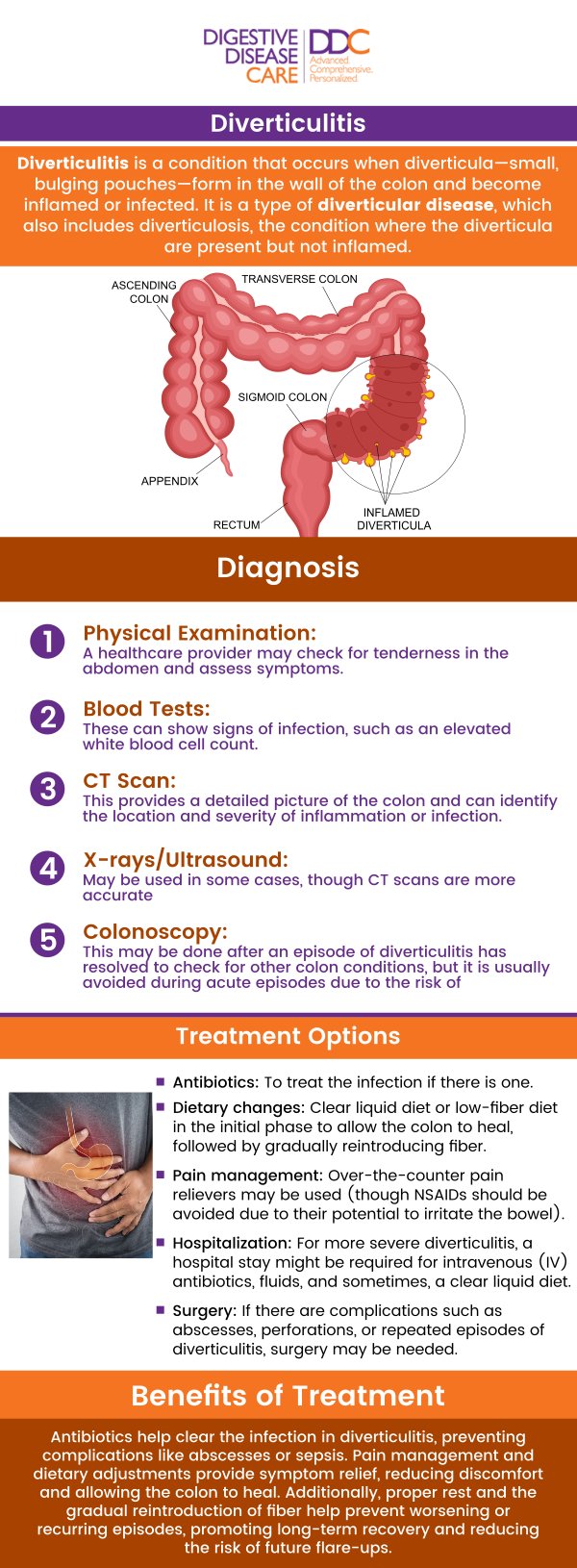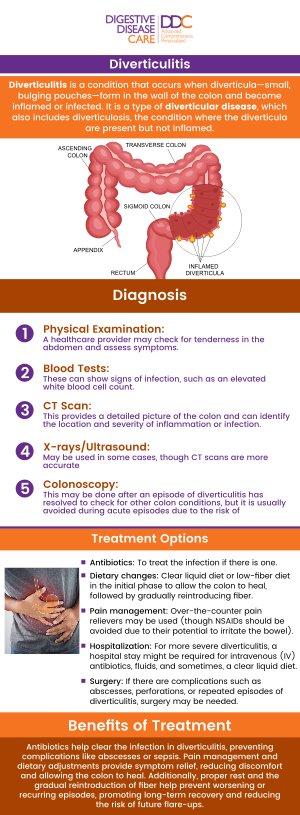Common Symptoms of Diverticulitis
Diverticulitis commonly causes abdominal pain, usually on the lower left side, along with changes in bowel movements such as constipation or diarrhea. Other symptoms may include fever, nausea, and bloating. At Digestive Disease Care, our gastroenterologists provide expert diagnosis and treatment to manage and alleviate symptoms effectively. For more information, contact us today or schedule an appointment online. We have convenient locations to serve you in Babylon NY, East Setauket NY, Forest Hills NY, Jericho NY, Lake Success NY, Melville NY, Mineola NY, Massapequa NY, New Hyde Park NY, and Riverhead NY.


Table of Contents:
What are the common symptoms of diverticulitis?
Can diverticulitis cause severe abdominal pain?
Is it normal to experience changes in bowel movements with diverticulitis?
How long do the symptoms of diverticulitis last?
Diverticulitis is a condition that occurs when small pouches (diverticula) that form in the walls of the colon become inflamed or infected. While some people with diverticulosis (the presence of diverticula) may not experience symptoms, diverticulitis can lead to more severe issues and requires medical attention. The symptoms of diverticulitis can vary from mild to severe, depending on the extent of the inflammation.
Common Symptoms of Diverticulitis:
1. Abdominal Pain
The most common symptom of diverticulitis is abdominal pain, often felt in the lower left side of the abdomen. The pain can be sudden and severe, and it may worsen with movement or after eating.
2. Changes in Bowel Habits
People with diverticulitis may experience changes in their bowel movements, such as constipation or diarrhea. Some individuals may also feel a sense of incomplete bowel evacuation.
3. Fever
A mild to moderate fever is common due to the infection or inflammation of the diverticula. The fever can be accompanied by chills or night sweats in some cases.
4. Nausea and Vomiting
Nausea and vomiting may occur, especially if the inflammation or infection worsens. These symptoms can make it difficult for individuals to eat or keep food down.
5. Bloating and Gas
Individuals with diverticulitis often experience bloating or a feeling of fullness. Increased gas and abdominal tenderness may also accompany these symptoms.
6. Rectal Bleeding
While less common, some people with diverticulitis may notice blood in their stool. This can indicate bleeding from the inflamed diverticula.
If you experience these symptoms, especially severe abdominal pain or fever, it’s essential to see a doctor promptly to prevent complications like perforation or abscess formation.
Diverticulitis can cause severe abdominal pain. This pain is often the primary symptom of the condition and varies in intensity depending on the severity of the inflammation or infection. Here are some key points to consider:
Key Points on Abdominal Pain and Diverticulitis:
1. Location of Pain
The pain typically occurs in the lower left side of the abdomen, where most diverticula forms. In some cases, especially in right-sided diverticulitis, the pain can be felt in the lower right side.
2. Pain Intensity
The pain can range from mild to severe. In many cases, it can be sharp, cramp-like, or constant, and it may intensify when moving, coughing, or after eating.
3. Sudden Onset
The pain often appears suddenly and can worsen over time, making it difficult to perform daily activities. For some individuals, the pain becomes so intense that it disrupts normal functioning.
4. Worsening with Inflammation
As the diverticula becomes inflamed or infected, the increased pressure within the colon can cause the abdominal pain to worsen. The swelling can put pressure on surrounding tissues, intensifying the discomfort.
5. Complications Leading to Increased Pain
If diverticulitis becomes more severe and leads to complications like perforation, abscess formation, or peritonitis, the pain can become even more intense and life-threatening.
6. Associated Symptoms
Severe abdominal pain may be accompanied by other symptoms such as fever, nausea, vomiting, changes in bowel habits (constipation or diarrhea), and sometimes rectal bleeding.
If you experience severe abdominal pain along with other symptoms, it is essential to seek medical care promptly to prevent complications and receive appropriate treatment.
It is normal to experience changes in bowel movements with diverticulitis. Diverticulitis occurs when small pouches (diverticula) in the colon become inflamed or infected, which can disrupt normal bowel function. People with diverticulitis often experience symptoms like constipation, diarrhea, or a combination of both.
Common Bowel Changes in Diverticulitis:
1. Constipation
Many individuals with diverticulitis experience constipation due to inflammation or narrowing of the affected part of the colon. The condition can make it harder for stool to pass through, leading to less frequent and difficult bowel movements.
2. Diarrhea
Some people may experience diarrhea during a diverticulitis flare-up. This can happen as a result of infection or irritation of the colon, causing the body to expel waste more quickly than normal.
3. Alternating Bowel Movements
In some cases, individuals may alternate between constipation and diarrhea, as the inflammation can fluctuate in severity.
4. Increased Urgency or Incomplete Bowel Movements
Diverticulitis can cause a sensation of urgency or an incomplete bowel movement, where the individual feels the need to go frequently but cannot fully empty their bowels.
If you experience significant changes in bowel movements, especially with other symptoms like abdominal pain, fever, or nausea, it’s important to see a doctor for proper diagnosis and treatment.
The duration of diverticulitis symptoms can vary depending on the severity of the condition, the effectiveness of treatment, and whether complications arise. In general, mild cases of diverticulitis may resolve within a few days to a week with proper treatment, while more severe cases may take longer to heal.
Typical Duration:
1. Mild Cases
For individuals with mild diverticulitis, symptoms such as abdominal pain, fever, and changes in bowel movements may improve within a few days to a week, especially with antibiotic treatment and dietary adjustments.
2. Moderate to Severe Cases
In more severe cases, symptoms may persist for weeks, particularly if the infection or inflammation is more widespread.
3. Complications
If complications such as abscesses, perforation, or peritonitis occur, the symptoms may last longer and require more intensive treatment, including surgery. Recovery can take weeks or even months, depending on the severity of the complication and the treatment required.
Post-Treatment Recovery:
Even after symptoms subside, some people may experience residual discomfort or changes in bowel habits as the colon heals. Follow-up care, including dietary changes and lifestyle adjustments, can help prevent future flare-ups.
It’s important to seek medical attention if symptoms persist or worsen. For more information, contact us today or schedule an appointment online. We have convenient locations to serve you in Melville NY, New Hyde Park NY, Forest Hills NY, Jericho NY, Mineola NY, Lake Success NY, Babylon NY, East Setauket NY, Massapequa NY, Riverhead NY and BEYOND.

Check Out Our 5 Star Reviews


Additional Services You May Like

Additional Services You May Like
- Abdominal Pain
- Acid Reflux
- Barretts Esophagus
- Bloating
- Capsule Endoscopy
- Celiac Disease
- Colon Cancer Screening
- Colonoscopy
- Constipation
- Crohns Disease
- Diarrhea
- Diverticulitis
- Esophageal PH Monitoring
- Fatty Liver
- Fibroscan
- Gallstones
- Gastroenterologist
- Gastric Chest Pain
- Gluten Intolerance
- Hemorrhoid
- Hemorrhoid Banding
- Hepatitis
- Irritable Bowel Syndrome
- Lactose Intolerance
- Pancreatitis
- Polyps
- Rectal Bleeding
- Stomach
- Ulcerative Colitis
- GI Urgent Care





